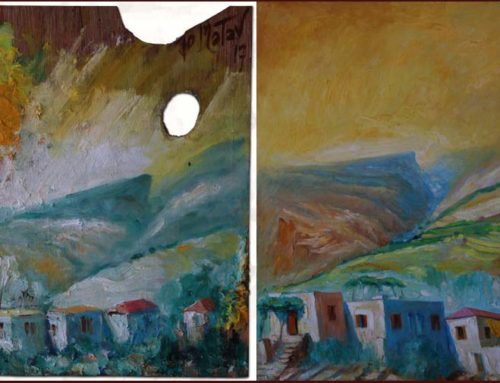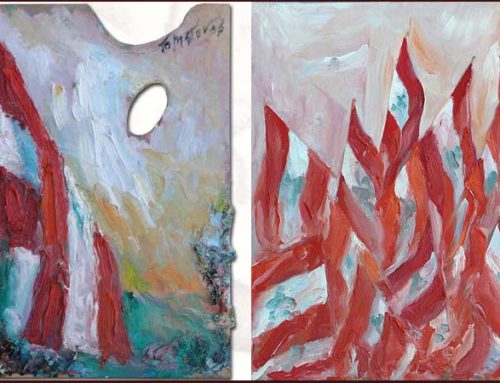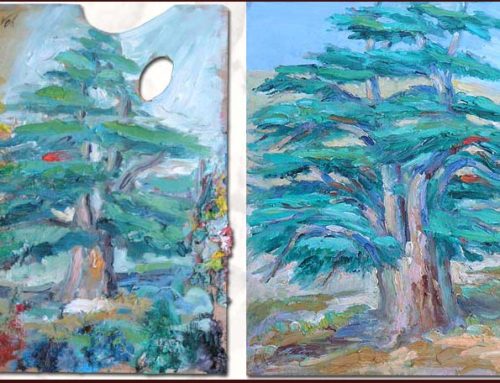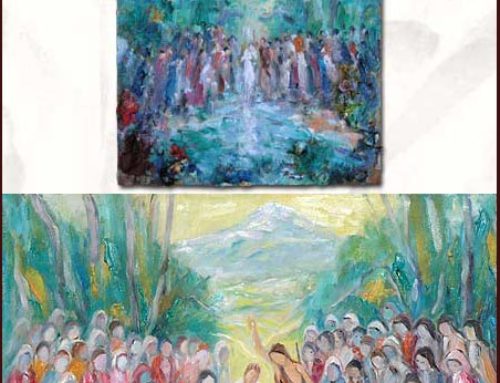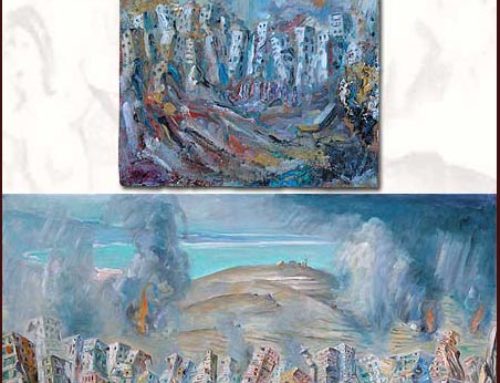A Monk with a Vocation
What is a vocation? It is an inclination to a certain kind of life, particularly in religion or the priesthood. It is most marked in Lebanon with its three sacred mountains, Hermon of the Transfiguration, Sannine raising its giant head between two worlds the Mediterranean and of Asia, and Cornet es-Sawda with its ancient Cedars of Bible fame. They are a gift of God in this holy land and their heights have always drawn chosen Lebanese towards sanctity.
And what of this Order of monks I have known all my life, deep-rooted in Lebanon and mingling with its people, sharing their joys and their woes? It has already given canonized saints to the Universal Church. However, any Order is a mixed bag; some members are intoxicated with love of God and some are scholars, intellectuals and thinkers, while there are other members looking only for prestige with the least possible effort. Some are politicians and some study abroad with no worthwhile result. Most importantly there are monks whose real achievements are many. The Order of Lebanese Monks that I know so well has labored fruitfully all over Lebanon.
Some of my class-mates, when I met them again in later years, were happy to have chosen a life in the Order and to have so served God and their fellow men. One of their monasteries has a name that takes one back to the Roman Emperor Augustus and to King Philippe-Auguste of France. But inscriptions engraved in the ruins also speak of a Roman lady called Augusta. Then you have the nearby town of Ghusta, evidently named after her, standing on a high hilltop from where it looks almost vertically down on the sea 2,500 feet below, lapping the shores of the breath-taking Bay of Jounieh.
A certain notable of Ghosta, Hanna Saba, was famed for his courage, generosity, defense of the weak, and help for the distressed. He had many children, one of whom I remember in class with me at the school of the Marist Brothers. The youngest boy, Martin or Martinos, I got to know later as Father Saba when I was visiting the Holy Spirit University at Kaslik (pronounced Kassleek) near Jounieh. He was small, young and dynamic with an open expression and piercing eyes, an active presence in his community. I was quick to notice that he was decisive of manner and ever ready to help, and that all solutions passed through him. Of useless intellectual pretensions he had none.
Father Saba-Martinos said he remembered me from the time we were at the Marists’, where I had been in the section of older boys and did not notice him. I may add that the standard of the school was excellent and there was a system to oblige us to speak French in recreation. Martin was the pride of his father Hanna. Families in those days were especially attached to any member who aimed at the priesthood and would be a link for them with Heaven.
I always saw in Father Martinos that kindness so typical of our Maronite believers, and he was full of life, setting everything around him in order. In 1964, on my return from studies in Madrid, I was asked to give the young seminarists at the Holy Spirit University of Kaslik a formation in art and so I installed a studio. In this way I often saw Father Martinos as well as the Father Rector and other monks, particularly when we met for coffee to discuss the situation, ideas and projects. Father Martinos I saw busy all over the place. He had no assistant or secretary but dealt directly with workers and subordinates. He was the hand behind every feast-day celebration, and event. However, this was always without any fuss or publicity. He celebrated his Mass quietly and prayed alone in peace of soul and union with the Lord.
He succeeded in everything. He tended the university gardens and controlled the car-park at the entrance. The buildings are of attractive yellow stone. But the architecture (work of a “communist”!) is unsatisfactory. There is no interior patio, no intimacy. Despite the many corners and corridors, there is only one entrance to the campus. The monastery has no place for meditation and there is no feeling of sacredness. Each monk can park his car near his own room and there is no architectural unity. My own contribution was two massive millstones from an olive press that I bought in a Druze village of the Shouf where I had been invited.
I got to know Father Martinos better and better, a man with a warm heart, tolerant, with a broad outlook and understanding of modern life as it evolved in all its aspects. He loved Lebanon but kept well out of politics. He never gave lectures or published books, leaving all that to the learned holders of doctorates. To write a thesis and earn the title of Doctor may well be an achievement but to be a true priest is something else, a call from above.
Father Martinos lived in a permanent worksite. He felt it his duty to build the Church up and improve it. On one occasion his expression showed anxiety over possible failure on his part. After Sunday Mass in the church of a monastery where he was superior, a Mass sung beautifully and enthusiastically by the entire congregation, he asked a certain visiting Englishman what he thought of the Mass. The Englishman said there was just one thing missing. Father Martinos looked very concerned and asked what that thing was. “There was no collection-plate!” said the Englishman with typical dry humor. Father Martinos then laughed and said God had already given his monastery everything in abundance.
His ambitions were all for his Order, his real family, and he had no time for newcomers with airs of modernity and superiority. There were two monks, brothers, one of whom made Contestation the subject of his thesis. Only two weeks later he left the Order, although a serious and likeable fellow, and his brother followed his example after another two weeks. Being a great intellectual and contester is not enough for a religious vocation.
There are also individuals who are not at all broad-minded enough to consider a synthesis and to adapt to a new situation. But was not Christ himself a revolutionary?
As a child, little Martin lived at Ghosta, where there were several monasteries, religious houses, and churches among the pine woods. Among the loveliest was the monastery of Our Lady of Nesbay. Not far away is Jounieh, where there have always been some of the best-known schools in Lebanon, run by priests or nuns, and where there is the charming bay dominated by the shrine of Our Lady of Lebanon. She is called upon by the fishermen when the rough sea threatens their boats.
One fisherman, on losing control of his boat, is aid to have implored the Holy Virgin to take him home safe and sound, at the same time making a vow to walk the six miles from Jounieh to Harissa with his shoes full of lentils, and also to change his drinking habits and way of life. Our Lady saved him and with a calmer sea he returned to shore. Then to fulfill his vow he set out for Harissa with his boots full of lentils.
However, he soon returned home, unable to take another step. Finally, he boiled the lentils over the fire, put them in his shoes, and set off again, leaving his wife to wonder at his artfulness.
We are talking of a time when there was no pollution and the only outsiders were students in the schools. Little Martin grew up in this family atmosphere but I had no contact with him, although, he later told me, he knew me as his elder at school. When around the year 1964 my art studies led me to Madrid, the young Martin was following university studies for the priesthood and the monastic life, mostly at the new university of the Holy Spirit at Kaslik near Jounieh.
But he was not to work in the academic field himself, being more concerned with the infrastructure of his Order. It did not yet possess the monastery of Saint Anthony at Ghazir nor the college of the Marist Brothers in Jounieh. The headquarters were in a small house in Beirut, but the main activity was centered on Kaslik University of the Holy Spirit. The monks working in the University under its Rector lived under the authority of the Superior of a small monastic house adjacent. Here Father Martinos Saba was busy with food, supplies, maintenance work and the general economy.
The 1970s saw black days for Jordan, the Cairo Agreement and terrorism, combined with the hypocritical policies of the West serving its interests. Trouble and civil strife broke out in Lebanon, with various parties seeing to their own defense and young people learning the use of weapons.
Crowds forming at Kaslik called for the benediction of the monks, known to receive guidance from the Vatican. The crowds were concerned only with protecting their own area from invasion, not with attacking others. A very small group, never more than a hundred, was formed on the heights of Kessrewan by two or three monks acting without any official authorization of the Order, acting rather in the role of army chaplains.
And what was Father Saba doing in all this? He was the real force acting in the group, providing clothes, provisions, material, ammunition and instructors, and this was an opportunity to really get to know him with his spirit of devotion and self-sacrifice. Our group was short-lived, for it was thought that the election of a new President would bring peace. In fact there ensued war between militias and Palestinian groups, with Israel and the hypocritical West working behind the scenes through their agents.
As I was spending every morning at the Holy Spirit University, I used to see Father Martinos almost daily. He was always very busy, with many projects in hand. A religious Order is a very democratic institution, with its superiors elected by all the members. Sometimes there may be indirect political interference behind the scenes but our Heavenly Father is also there.
One of our UN ambassadors told me the following story for a laugh. A young couple decided to marry and whenever the young lady asked her husband about the choice of house, furniture, kitchen equipment, school for the children, and so on, her partner told her not to bother him with such minor affairs. He had major affairs to deal with. As the family grew up she finally asked him what these major affairs were. He said, “Oh! Vietnam, Korea, the Ukraine, the Arab Spring and such matters!” Poor young woman, she was exploited! In the Lebanese Order there are no such “major affairs”, only small ones, but these are of importance to be treated with love and competence, concerning the building of churches, schools and monasteries, social affairs, helping the destitute and the sick, parochial service, and saving souls, as well as devotion to prayer. In all these matters Father Martinos labored uncomplainingly, always finding solutions to problems, for even in a religious Order there are dynamic devoted individuals and others who live at their expense.
The Holy Spirit University rose from a monastery, seminary and then all-male university with two or three faculties to become a full-blown University for men and women. This meant transferring the seminary to the Notre Dame monastery at Ghosta and also creating a faculty of Architecture with laboratories, lecture halls and a car park. This was done without making used of existing basements and I think that Father Martinos held aloof.
There were changes in the top administration and Father Saba Martinos was sent to be superior of a monastery not very far away, an order which he dutifully obeyed. From early times, from Syria and Egypt to France and the British Isles, monasteries grew up that sometimes had a thousand monks, who included professionals and craftsmen of every description. Some of these monasteries grew up in the urban centers and were engaged in various socially useful activities and others in the countryside and remote places where they sheltered hermits. In the mountains of Lebanon monasteries developed after the arrival of disciples of Saint Anthony from Egypt and of disciples of Saint Maron come from Northern Syria in the fifth century and finally these were organized into Orders. Lebanon had relations with Europe and all Christendom, and monks came to its mountain retreats even from Ethiopia.
The monks in each monastery were rarely more than ten or twelve, except for the seminaries after the crises of 1840-1860. The monks of the order of Saint Anthony Kazhaya were said to number more than eight hundred. They devoted themselves entirely to their Order, building churches and monasteries and making terraces over the mountain slopes to support crops and olive trees. The monks found satisfaction in their work in the fields and the workshop, passing on their skills to the peasants among whom they lived. The more educated ones taught them the catechism and some basic literary Arabic and French.
There are many orders for monks and sisters in Lebanon and their golden age was the second half of the nineteenth century and the early twentieth, a time of many saints, men and women. Ever since the 1960s I have been visiting monasteries, convents and presbyteries and have always felt there an atmosphere of prayer and sanctity. Sometimes I found just one elderly monk in a large old building with abandoned property; he would be cultivating some small plot while also looking after the chapel and serving the odd faithful who came to pray. Some times the authorities of their Order, working in the cities or universities sent their novices during the summer break to help them keep the property productive. In Lebanon in fact there are no monasteries in ruins, for all have been restored and are the scenes of activity.
The first mission of these monks is to be close to the peasants in their daily life, but now they have wider horizons, for they teach in primary and secondary schools and in universities. Is this a good thing or a bad thing? Does academic work interfere with the monk’s contemplative life? A good monk who is intelligent and educated can always serve the public by setting an example of prayer and by teaching and preaching. Fra Angelico was an outstanding painter and artist!
Monks have always been thought to be erudite people. The Dominicans were founded to be theologians and preachers. But after Saint Anthony, did the founders of the Orders foresee this evolution? Whatever the case may be, times change and so do the needs of life with people’s ideas, and each has to work in the field allotted to him. Once upon a time the peasants would come and lend a hand in the monasteries to help them stay prosperous and fruitful. So, during the First World War. the Lebanese Order mortgaged all its property to buy basic foodstuffs for all Lebanese, irrespective of their religious attachment.
In 1975 violence, even warfare, broke out in Lebanon, pitting Palestinians, Leftists and Lebanese nationalists against one another. The Palestinians were wrong to bear arms against the Lebanese who had earlier shown them hospitality. In any case, the only result was that the Palestinians ruined their cause. The Lebanese suffered greatly and their infrastructure was fractured, but I believe that in the long run it will be not the Lebanese but their adversaries who will have to pay the cost. One thing is clear, namely that if the Christians are at peace and are secure, then everybody else in the country will be also.
Father Martinos could no longer rest at night, feeling it his duty to help everybody without discrimination. When Christian extremists took two railway coaches heading to Tripoli as hostages, Father Martino did all in his power to get them freed, insisting that he was acting out of love and taking no count o individual beliefs. We would discuss the situation together, unhappy to see the Western Powers doing nothing to end the crisis! For his part, Father Martinos exerted every effort to obtain fuel, wheat and flower for the bakeries and medicines for those needing them.
We next saw Father Martinos busy at the little monastery of Mar Yusuf el-Borj, Saint Joseph of the Tower, situated on a hill dominating Nahr el-Kalb and facing the sea, only five minutes by car from Kasli. The only problem was its proximity to a “camp” of Palestinians on its western approach, on land given by the Lebanese Maronite Order in 1948 to Christians expelled from their homeland.
With the rise of Yasser Arafat, the Palestinians believed themselves all-powerful, setting up road-blocks, inspecting cars, and behaving in a threatening manner, forgetting how originally they had been warmly welcomed. Once Father Martinos was stopped by an armed group at a road-block and told to park his car on one side. He told them that he was not frightened of them, they were ungrateful wretches, and that they were to get out of his way. After some murmuring among themselves, the Palestinians let him pass. The great problem of the Palestinians, who have a just cause, is to have put themselves under UNRWA and so become beggars living at the expense of the United Nations, when a single Arab oil-well would have sufficed to maintain them. For his part, Father Martinos Saba managed to keep the situation under control until finally the 8th Battalion of the Lebanese Army forcefully restored order once and for all. The beautiful hill is now surrounded by hotels and tourist attractions but is above all a point of great strategic importance and an impregnable fortress.
As soon as he took over the monastery, Father Saba set about restoring and refurnishing it and putting back some life into the place, with pilgrims coming to find a retreat for prayer and meditation. I myself restored the wall-painting in the chapel. In every monastery where he passed, Father Martinos Saba left his mark. If there are fewer vocations, this must be corrected by a return to the sources, to simplicity, faith, and love of one’s neighbor.
While superior at Mar Yusuf el-Borj, Father Saba often passed by Kaslik, where also he had much to do. After his four-year term at Mar Yusuf, found himself the superior of another monastery, St. Roch (Rock, Roukosz), at Daraya on the road linking Kesserwan to the Metn through Bikfaya. Soon he was engaged in a wide project of restoration, adding glass to the arcades of the cloister to give parishioners protection from intemperate weather, and bringing the surrounding land under cultivation with fruit trees of every kind. The number of monks increased while the faithful found the interior of the church in pristine condition.
Father Martinos was also burning with desire to serve the people of the region around, particularly when he noticed the buses carrying children every day to distant schools; so the next thing was to build a school adjacent to the monastery, entirely on his own initiative and depending on his own resources despite all the risks and difficulties involved. When there is a will, there’s a way, as shown by the example of the hospital of Our Lay of Perpetual Succor at Byblos, the foundation and success of which has been due entirely to the energy of a certain Father Elias.
On a barren stretch of rocky land, Father Martinos built his school and cultural center, while strictly respecting the natural beauty of the landscape, for he is both progressive and conservationist. As well as the usual academic courses in the school there are many other activities, such as drawing, painting, dance, theater, and sports even including horse-riding, with steeds ready in a stable.
But for Father Martinos Saba there is still no rest. For one thing, he makes no distinction between social classes. He remembers the example of Ambroise Paré, Father of modern surgery. When King Charles IX said to him that he hoped that Paré treated kings better than the poor, Paré answered that this was impossible, for he treated the poor like Kings and God restored their health. Father Saba was particularly upset by the conflict between Christians, between fellow-Maronites, as when the forces of General Aoun at Bikfaya opposed the militiamen of the Lebanese Forces across the valley at Kleyaate. The monastery came under heavy fire from both sides. Father Martinos Saba sheltered in the deepest recesses and when peace returned lost no time repairing the extensive destruction caused by militiamen who claimed to be Christians defending their fellow Christians!
Father Saba noted in the monastery diary all the events. When a projectile shattered part of the monastery it was as though a part of himself had suffered. He prayed to God for an end to the violence and many highly placed personalities of every religious obedience passed by St. Roch to inquire about the well-being both of the monastery and of its superior. Father Saba is open to everybody for any constructive dialogue. But unrealistic utopian ideas do not interest him. Educating the young, spreading culture, strengthening family ties, agriculture, providing work for the jobless, preaching the Gospel, these are what matter to him.
At Ghosta, twenty minutes by road from St. Roch, is the famous monastery of Our Lady of Nesbay, residence for the seminarists studying at the University. Closer at hand at Ajaltoun is Saint Shallita, where a couple of monks serve the parish. There is another monastic property at Mayrouba, and to the south at Beit Shebab near Bikfayais is one of the largest schools or monasteries of the Lebanese Order, now handed over for the care of the handicapped as an institution run by leading specialists.
Saint Roch stands at the center of this network of monasteries, and now it has become surrounded by residential buildings and by several impressive restaurants that make the area a resort in summer with swarms of clients. Only fifty years ago this monastery was lost among the trees, with no road to it, only a footpath along which passed occasional flocks of goats. Now Saint Roch continues a tradition that from the first Christian centuries made monasteries from Lebanon to Mesopotamia centers of culture and progress; when they are destroyed a light is put out.
In the vast Ottoman Empire that subjugated the region for five centuries, there was no voice raised against the injustice, oppression, massacres and terror other than that of those Maronite monks who had gone to the West, to nations that had consuls in Lebanon which for various reasons were respected in Istanbul and could bring pressure to bear. Thus the voice of the monks was heard on earth as well as in heaven. Recent saints such as Hardini, Rafca and Sharbel followed in the wake of countless hundreds of holy monks throughout history. And if now there are some who are of indifferent quality and self-serving, there are an impressive number who follow the example of their holy predecessors.
In the past, monks and peasants followed the same rhythm of work, prayer, eating, fasting and feasting. There were no shops or bakeries and the bread was baked at home or in the monasteries and shared by all. The peasants sent their children to the monks to learn the elements of reading and writing, using the Bible and liturgical books, and the boy who had read the Epistle during Holy Mass would return home bursting with pride. Apart from the hermits, the monks were not cloistered but shared the joys and sorrows of those around them, teaching them, helping them and treating their illnesses. Father Martinos follows their tradition. He is not unique but I take him as an example of those who give themselves with passion to Our Lord in their prayer and in their work. His labors are not ended. He never ceases to improve what he has already founded. He grows older and has had to go to hospital several times, but when overtired he always takes refuge in prayer. He is fully aware that times change as do ways of life, customs and human relations. But it is my own belief that the Orders in Lebanon are prepared and qualified to face every evolution. Christ’s mission has no limits in time and space and Christianity may be only at its beginnings. It may be that in five thousand years’ time Christ’s message will have spread to the whole of humanity. I am sure that such a time will find the Lebanese Order continuing to raise saints to God.
Fatherhood is not something biological but is a matter of social and community conceptions. And to live up to one’s vocation it is not necessary to have a doctorate from Strasbourg or Paris; love, faith, tolerance, pardon and self-sacrifice are what are needed. These qualities are certainly not lacking in Father Martinos, who throughout his whole life has been active, devoted, loving, generous, planning, directing and visionary.
The people of Ghosta are proud of their parish church, under the protective patronage of Our Lady, and of all the other churches and religious houses, of which there are dozens. Formerly municipal administration and services did not exist, but of their own accord the inhabitants kept the streets cleans, with flowers and greenery everywhere. It is from such a people that vocations are drawn.
Father Martinos is a man with a firm conviction that he passes on in his preaching as do so many monks of his Order. He is the sower who under the eye of God wishes all his seed to fall on good soil and grow. The soil is always more fertile after Father Martinos has passed by, whether at Kaslik University or at the monasteries of Mar Yusuf and Mar Roukoz. He has never set his eyes on high office in his community but has always been the servant of others, working in silence in the shadows, without fuss or show.
I drop in on him from time to time with some friends who share his ideals in a relationship that goes back fifty years. We are always received with a smile but do not forget that there is another side to this intimacy. Only Father Martinos can give a full account of the days when there was warfare between the regular army and the militiamen. That was a difficult time for the monastery halfway between the two adversaries and under their heavy fire. It was saved only by the courage of the Father, who like a good captain never left his ship.
The Maronites have deep affection for their monks despite modern leanings towards a secular society. A true Christian cannot separate the world, society, public life and religion. There is here a problem to be resolved between respect for civil rights, liberty for belief, and the inner religious life. It is by respecting individual freedom that Lebanon has survived over the centuries. Mutual help and charitable effort are things that have come from the Christian spirit in the West as in the East.
Father Martinos has done nothing for his personal advantage; he is just an element in this wonderful great Maronite Order, working only for God, the Order and the social community. So he may be considered as living up to his vow of poverty, no easy thing in these modern times. The Master taught love of God and of one’s neighbor, and also said, I am eternal life, the way, the spiritual food,’ something which even the great thinkers of ancient Rome and Greece dared not say. Who else could say it other than the Creator himself? All our holy monks have lived up to his words, drunk of his water, eaten of his food, and followed his way.
At present, some religious congregations allow their members to choose where they are going to make their yearly retreat – Rome, Florence, Paris, Rio or Montreal. This entails a budget and expenses quite unnecessary for a week of prayer. When I raised the question of such waste with a seasoned monk, he answered that he himself preferred to go to one of the old monasteries up in the mountains. Certainly, times have changed and for the least pretext, the young ones jump into a plane to go anywhere in the world instead of praying and attending the liturgy at home. But such is not the idea of Father Saba, who thinks that the vows of poverty and obedience should be applied and strictly followed. Several monasteries have set up centers where the faithful, pilgrims and tourists, can spend a few days to find peace of soul and acquire the spiritual forces that they need. Such spiritual tourism attracts many Lebanese emigrants, Europeans, and members of the general public and is well within the objectives of Father Martinos Saba. I am sure that such a project will receive an enthusiastic response so that isolated and neglected monasteries will become hives of spiritual life and action.
St. Rock, where Father Martinos Saba is at present, is a typical monastery and here he devotes himself to the service of others as he has always done.
Joseph Matar
All rights reserved © LebanonArt
Adapted from the French by Kenneth Mortimer



